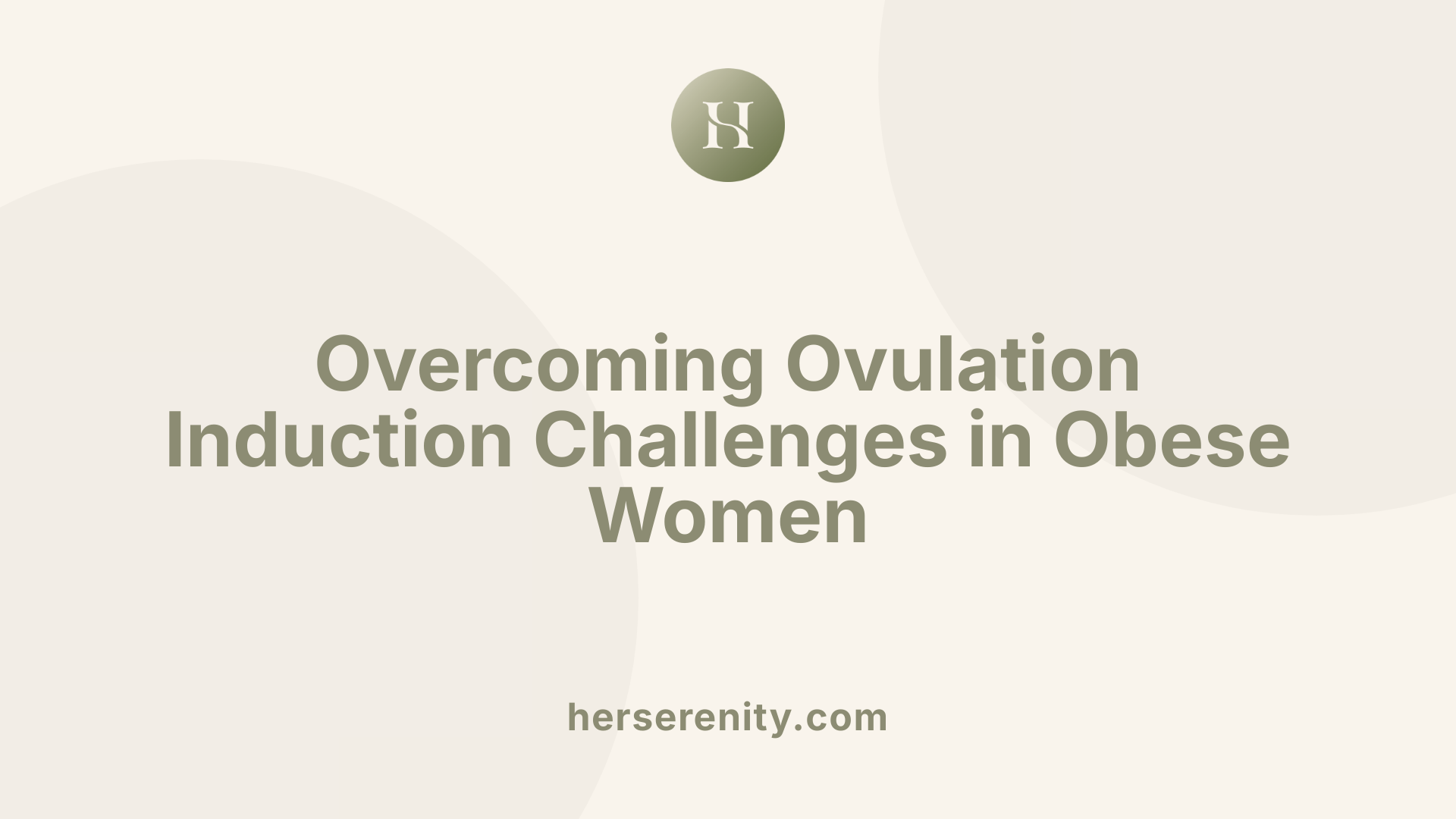How weight and BMI influence fertility treatments
Unraveling the Impact of Weight and BMI on Fertility Treatment Success

Understanding the Link Between Body Weight and Fertility
Body weight and body mass index (BMI) are increasingly recognized as key factors influencing reproductive health and the efficacy of fertility treatments. With obesity reaching epidemic proportions globally, understanding how elevated BMI affects ovulation, conception chances, and outcomes of assisted reproductive technologies (ART) is essential for both patients and clinicians. This article explores current evidence on the impact of weight on fertility treatments, the mechanisms underlying reproductive challenges in overweight and obese individuals, and emerging strategies to optimize reproductive outcomes through weight management and personalized care.
Common Medical Treatments for Assisting Conception

What are the common types of medical treatments available for assisting conception?
Medical treatments for assisting conception vary depending on the underlying cause of infertility, patient age, and individual health factors. The most frequently used approaches include medications for ovulation induction and assisted reproductive techniques (ART).
Medications for Ovulation Induction involve drugs like clomiphene citrate, gonadotropins, and letrozole. Clomiphene citrate is often the first-line treatment to stimulate ovulation; however, obese women tend to respond poorly to it and usually require higher doses of gonadotropins. Gonadotropins are injectable hormones that directly stimulate the ovaries to produce multiple follicles, but obese women generally need larger doses and may produce fewer oocytes as a result.
Assisted Reproductive Techniques encompass procedures such as intrauterine insemination (IUI) and in vitro fertilization (IVF). IUI involves placing sperm directly into the uterus during the fertile window to increase chances of fertilization. IVF fertilizes eggs with sperm outside the body and transfers the resulting embryos into the uterus. A specialized form of IVF, intracytoplasmic sperm injection (ICSI), involves injecting a single sperm directly into an egg, mainly used to address severe male infertility. In some cases, egg or sperm donation is included, particularly when ovarian reserve is low or genetic concerns exist.
Considerations for Treatment Selection
Treatment choice depends on multiple factors including cause and duration of infertility, patient BMI, and age. Obesity negatively affects ovarian response and embryo quality, reducing success rates of treatments like IVF. Higher BMI patients may require modified medication dosages, and treatment centers often tailor protocols accordingly. Additionally, lifestyle measures including weight loss—ideally gradual and sustained—may improve ovulation and fertility outcomes, sometimes reducing the need for aggressive medical treatments.
Surgical options may also be considered to correct conditions like endometriosis or tubal blockages, complementing medical and ART methods.
By understanding these varied treatments and their adjustments for BMI-related challenges, clinicians optimize chances of conception while minimizing risks.
How Fertility Specialists Tailor Treatments to Individual Couples

How do fertility specialists determine the most appropriate treatment for a couple?
Fertility specialists begin with a comprehensive assessment of both partners. This includes reviewing medical history, physical exams, hormonal blood tests, and imaging like ultrasounds to uncover issues such as ovulatory problems, tubal blockages, or sperm abnormalities. They consider critical factors including the woman's age, ovarian reserve, BMI, hormone levels, and overall health. These details guide the choice of treatments ranging from intrauterine insemination (IUI) to in vitro fertilization (IVF), or the use of donor eggs or embryos.
Personalization of care is essential. Specialists evaluate how obesity or BMI affects reproductive potential. For example, higher BMI in women can impair ovulation and reduce response to ovarian stimulation, often requiring higher medication doses and leading to lower success rates. Treatment plans accommodate these biological factors by adjusting medication protocols or recommending weight management strategies before starting advanced therapies.
Fertility experts also integrate the couple's preferences, emotional readiness, and financial considerations. They discuss the pros and cons of each option, including the potential for natural conception versus assisted reproductive technologies. When natural conception is unlikely, or prior treatments have failed, IVF is commonly advised, especially in cases with ovulatory dysfunction or male factor infertility.
In summary, the approach to fertility treatment is multidimensional—anchored in thorough medical evaluation, consideration of BMI and its impact, and respectful of the couple’s goals and circumstances to optimize outcomes.
BMI and Ovulatory Function: The Link to Infertility

How does high BMI impact ovulation?
Women with increased BMI, particularly those classified as obese (BMI > 30 kg/m²), often experience ovulatory subfertility and anovulation. Excess body fat disrupts normal hormonal balances, impairing ovulation which is critical for conception. This disruption leads to irregular or absent menstrual cycles, making natural fertility more challenging.
What are the mechanisms behind ovulatory subfertility and anovulation in obesity?
Obesity affects hormone profiles by lowering luteinizing hormone (LH) and follicle-stimulating hormone (FSH) levels, altering progesterone, and often causing hyperandrogenism, especially in women with polycystic ovary syndrome (PCOS). These hormonal changes interfere with the regular maturation and release of eggs from the ovary, resulting in ovulatory disorders.
How prevalent are menstrual irregularities in obese women?
Menstrual cycle irregularities are common in obese women, with prevalence rates ranging from 30% to 36%. The severity of these irregularities tends to increase as BMI rises. Disrupted menstrual cycles reflect underlying ovulatory dysfunction, further reducing fertility potential.
What is the interaction between PCOS and obesity?
PCOS is a common endocrine disorder characterized by ovulatory dysfunction and hyperandrogenism. Obesity exacerbates PCOS symptoms by intensifying hormonal imbalances and increasing the risk of ovulatory dysfunction. Thus, the combination of PCOS and obesity significantly heightens the risk of anovulation and infertility.
Overall, increased BMI negatively influences ovulatory function through complex hormonal disruptions, menstrual irregularities, and interactions with conditions like PCOS, all of which contribute to challenges in achieving pregnancy naturally or through fertility treatments.
Challenges of Ovulation Induction in Overweight and Obese Women

Response to Clomiphene Citrate
Obese women often exhibit a poorer response to clomiphene citrate, a commonly used medication for ovulation induction. This reduced responsiveness can make achieving ovulation more difficult compared to women with normal body weight.
Gonadotrophin Dosage Requirements
Due to altered hormonal profiles and decreased ovarian sensitivity, overweight and obese women typically require higher doses of gonadotrophins for effective ovulation induction and superovulation. This increased medication need reflects the challenge of stimulating the ovaries adequately in this population.
Ovarian Stimulation Outcomes
Ovarian stimulation in obese patients tends to produce fewer follicles, limiting the number of available oocytes. This diminished ovarian response complicates assisted reproductive techniques, such as in vitro fertilization (IVF).
Effects on Follicle and Oocyte Yield
Studies show that obese women undergoing ovarian stimulation yield fewer oocytes overall. This reduction in both the quantity and quality of oocytes can negatively affect fertilization rates and embryo development, ultimately lowering pregnancy success.
In summary, obesity presents significant barriers to ovulation induction. The challenges include diminished response to standard ovulation drugs like clomiphene citrate, a need for increased gonadotrophin dosages, and poorer ovarian stimulation outcomes. These factors contribute to fewer follicles and oocytes obtained, complicating fertility management in overweight and obese women.
Fertilization and Embryo Quality in the Context of Elevated BMI

How Does Elevated BMI Affect Fertilization Rates in Obese Women?
Research highlights that fertilization rates tend to be poorer in obese women, even those who are younger. This reduction in fertilization success is partially due to the negative effects obesity has on ovarian response and egg quality. Obese women often require higher doses of gonadotrophins for ovarian stimulation during fertility treatments such as IVF, yet still retrieve fewer oocytes, which may account for the diminished fertilization rates observed.
In What Ways Is Embryo Quality Impaired With Increased BMI?
Embryo quality is consistently found to be impaired in women with elevated BMI. Factors such as altered hormone profiles—including lowered luteinizing hormone and follicle-stimulating hormone levels—and the presence of hyperandrogenism contribute to suboptimal oocyte development. Consequently, embryos generated from obese women often show poorer morphological and developmental characteristics, which can lower the chances of successful implantation and pregnancy.
Are Younger Obese Women More Affected?
Notably, younger obese women experience a more pronounced impact on embryo quality and fertilization rates. This subgroup demonstrates compromised reproductive parameters even before age-related declines commonly seen in older women. Despite their younger age, obesity-related ovarian dysfunction undermines their fertility potential, underscoring the importance of addressing weight management early in reproductive years.
How Does Age Interact With BMI in Affecting Fertilization and Embryo Quality?
The interaction between age and BMI shows that older women (age 36 and above) may experience less influence of BMI on fertilization and embryo quality compared to the dominant effect of age itself. However, in younger women, BMI plays a significant role in reproductive function, suggesting that obesity independently damages fertilization potential and embryo viability regardless of age.
| Factor | Impact in Obese Women | Age Interaction |
|---|---|---|
| Fertilization Rates | Reduced, due to poor ovarian response and fewer oocytes | More evident in younger women |
| Embryo Quality | Impaired, poorer morphological features | Younger women show greater impairment |
| Hormonal Profile Altered | Lower LH and FSH, hyperandrogenism | Age may moderate the hormonal effects |
| Ovarian Stimulation | Requires higher gonadotrophin doses | Effect consistent but overshadowed by age in older women |
Pregnancy Rates and Risks Associated with High BMI
How Does High BMI Affect Pregnancy Rates?
Women with high BMI face lower pregnancy rates compared to those with normal weight. Obesity is linked to poorer response to ovulation induction and reduced ovarian stimulation outcomes, resulting in fewer follicles, fewer oocytes, and lower fertilization rates. These challenges often translate into diminished success in achieving pregnancy, both naturally and through fertility treatments such as in vitro fertilization (IVF).
What Are the Risks of Early Pregnancy Loss?
An increased risk of early pregnancy loss is notably higher among overweight and obese women. This elevated miscarriage risk is evident following spontaneous conception, ovulation induction, IVF, and even oocyte donation cycles. The mechanisms include impaired embryo quality and altered hormonal environments that negatively impact pregnancy maintenance.
What Complications Are Linked to High BMI During Pregnancy?
Obesity significantly raises the risk of several pregnancy complications. These include:
- Gestational diabetes mellitus
- Hypertensive disorders such as preeclampsia
- Premature delivery
- Cesarean section and other delivery complications
- Placenta previa
Certain severe complications, like preeclampsia with severe features and gestational diabetes requiring medication, are more common in women with very high BMI (≥40).
How Does High BMI Impact Perinatal Outcomes?
While neonatal outcomes such as preterm birth and NICU admissions don't always significantly vary by BMI, infants born to mothers with extreme obesity (BMI ≥50) often require longer NICU stays. Other adverse perinatal outcomes associated with high maternal BMI include low Apgar scores, increased neonatal intensive care unit admissions, and a higher incidence of birth trauma.
These risks underscore the importance of strategic management of maternal weight before and during pregnancy, especially in women undergoing fertility treatments. Counseling and medical intervention aimed at sustained weight loss may help improve pregnancy rates and reduce complications related to high BMI.
Weight Loss: A Strategy to Improve Fertility Outcomes
What effects does a 5-10% weight loss have on ovulation and conception?
Even modest weight loss of 5-10% of body weight can significantly benefit women's reproductive health. This degree of weight reduction has been shown to regularize menstrual cycles, increase spontaneous ovulation, and improve the likelihood of conception for overweight and obese women. These changes help restore hormonal balance and enhance fertility potential naturally without invasive treatments.
Are gradual weight loss methods better than crash diets for fertility?
Gradual and sustained weight loss is strongly preferred over rapid weight loss or crash dieting concerning fertility. Slow, consistent weight loss improves reproductive outcomes by enhancing oocyte quality and hormonal stability. In contrast, crash dieting may actually harm fertility by damaging oocyte quality and reducing fertilization rates. This demonstrates the importance of steady lifestyle changes rather than quick fixes.
What weight loss methods support reproductive benefits?
Weight reduction achieved through lifestyle modifications, such as balanced diets and increased physical activity, yields significant improvements in reproductive parameters. Medical therapies, including antiobesity medications like GLP-1 receptor agonists (semaglutide, tirzepatide), show promising weight loss results that may aid fertility though long-term pregnancy data remain limited. Bariatric surgery is an option for morbid obesity, offering sustained weight loss and improved fertility; however, pregnancy is recommended to be delayed for 12 to 18 months post-surgery to avoid fetal nutritional risks.
What role do lifestyle factors play in reproductive health and fertility?
Lifestyle factors are foundational to reproductive success for both sexes. Healthy behaviors such as maintaining an optimal weight, nutritious diets, avoiding tobacco and excessive alcohol, managing stress, and preventing infections can positively influence ovulation, sperm quality, and conception rates. Addressing lifestyle and metabolic health helps optimize fertility outcomes and supports healthier pregnancies.
| Topic | Summary | Implication for Fertility |
|---|---|---|
| 5-10% Weight Loss | Regularizes cycles, improves ovulation and conception | Enhanced natural fertility |
| Weight Loss Approach | Gradual > Crash dieting for oocyte and embryo quality | Safer, better reproductive outcomes |
| Weight Loss Methods | Lifestyle changes, medical therapy, bariatric surgery | Tailored to individual, with medical supervision |
| Lifestyle and Fertility | Healthy behaviors promote hormone balance, sperm and egg quality | Foundation of reproductive success |
Efficacy of Weight Loss Before IVF: Insights from Recent Studies
Meta-analysis of Weight Loss and IVF Outcomes
Multiple randomized controlled trials involving 1,627 overweight or obese women have investigated whether preconception weight loss improves in vitro fertilization (IVF) outcomes. A comprehensive meta-analysis of these studies showed that although weight loss interventions led to significant reductions in body weight (mean difference of -4.62 kg), this did not translate to clear improvements in key reproductive endpoints.
Clinical Pregnancy and Miscarriage Rates
The meta-analysis found no significant differences in clinical pregnancy rates between women who lost weight prior to IVF and those who did not. Similarly, miscarriage rates remained comparable across groups, indicating that pre-IVF weight loss alone may not influence these outcomes significantly.
Ongoing Pregnancy and Live Birth Data
Data also revealed that ongoing pregnancy rates and live birth rates after IVF were not substantially higher in women who achieved weight loss before treatment. For example, the odds ratio for live birth was 1.38 with a 95% confidence interval ranging from 0.88 to 2.10, highlighting a lack of statistical significance. These results suggest that while weight loss may benefit general health, its impact on IVF success specifically remains uncertain.
Impact of Weight Loss Timing
Importantly, the nature of weight loss matters; gradual and sustained weight reduction tends to be beneficial, whereas rapid crash dieting may adversely affect oocyte quality and fertilization. Additionally, some evidence points to the complexity of timing weight loss interventions, especially given that immediate pre-IVF weight loss has not been conclusively shown to improve live birth rates. Long-term, well-designed studies are needed to better understand optimal weight management strategies before fertility treatments.
In summary, current evidence indicates that although weight loss improves metabolic health and may have beneficial effects on ovulation and natural fertility, its direct effect on IVF outcomes like live birth rate and miscarriage is still inconclusive. Careful consideration of weight loss methods and timing is essential when counseling patients undergoing IVF.
Obesity’s Impact on IVF Procedures and Embryo Transfer
Higher Medication Doses Needed
Women with obesity undergoing in vitro fertilization (IVF) often require increased doses of gonadotrophins for ovarian stimulation and superovulation. This is due to reduced ovarian responsiveness linked to high body mass index (BMI), making medication management more challenging and often prolonged to achieve adequate follicular development.
Difficulty in Ovarian Stimulation
Obese women tend to have a poorer response to ovarian stimulation protocols. Studies show fewer follicles develop and fewer oocytes are retrieved during the procedure compared to women with normal BMI. This diminished ovarian response can negatively affect subsequent fertilization rates and embryo quality.
Technical Challenges During Egg Retrieval
Higher BMI creates physical barriers during IVF procedures. Increased adipose tissue complicates ultrasound visualization of ovaries and can make egg retrieval technically difficult, potentially prolonging procedure time and impacting the number of oocytes collected.
Embryo Implantation Variability
Embryo quality is often compromised in younger obese women, contributing to lower fertilization rates and poorer embryo development. Although implantation rates reduce with increasing BMI, some studies suggest variability depending on patient age and clinical settings. This reduced implantation success, combined with higher miscarriage rates, complicates achieving pregnancy through IVF.
These challenges emphasize the importance of tailored IVF protocols and specialized care for women with obesity to optimize reproductive outcomes.
Age as a Modifier of BMI Effects on Fertility Treatment Success
How does BMI impact fertility treatments in younger versus older women?
The influence of increased BMI on fertility treatment outcomes varies substantially between younger and older women. In younger women, obesity is closely linked to poorer fertility markers such as reduced fertilization rates, impaired embryo quality, and lower pregnancy rates. Conversely, in women aged 36 and above, the direct impact of BMI on the success of treatments like in vitro fertilization (IVF) appears less pronounced. This suggests that age-related reproductive decline can overshadow the effects of increased BMI in this group.
What are live birth rates relative to age and BMI?
Studies indicate a dose-dependent decline in live birth rates associated with increasing BMI, but this trend is particularly marked in younger women. For instance, the cumulative live birth rate drops from approximately 32.6% in normal-weight women to 7.6% in women with class III obesity (BMI >40). Although older women also experience reduced live birth rates, age itself exerts a stronger influence on reproductive outcomes, often complicating the attribution to BMI alone.
How does age-related reproductive decline compare to the influence of BMI?
Age remains the most significant determinant of fertility decline, with advanced maternal age associated with diminished ovarian reserve and lower response to ovarian stimulation. While high BMI disrupts hormonal balance and lowers ovarian responsiveness across all ages, its relative effect on fertility treatments diminishes in women over 36. Therefore, optimizing fertility outcomes in older women may increasingly focus on age-specific interventions, although weight management remains important for overall maternal and fetal health.
In summary, while obesity detrimentally affects reproductive parameters and treatment success more prominently in younger women, the compounding impact of aging may mitigate the relative influence of BMI in older patients undergoing fertility treatments.
Male Obesity and Its Effects on Fertility
How Does Male Obesity Affect Semen Parameters?
Obesity in men is linked to poorer semen quality. Specifically, obese men often exhibit oligozoospermia (reduced sperm count) and asthenozoospermia (decreased sperm motility). These impairments can reduce the likelihood of successful fertilization naturally or through assisted reproductive technologies.
What Hormonal Changes Occur in Obese Men?
Higher body mass in men correlates with hormonal imbalances, particularly decreased testosterone levels. Lower testosterone can contribute to reduced libido and erectile dysfunction. Additionally, excess adipose tissue can increase estrogen levels, further disrupting hormonal balance and fertility.
Does Male Obesity Impact Sperm DNA Integrity?
Alongside changes in sperm quantity and motility, obesity is associated with increased sperm DNA damage. This DNA fragmentation can impair the sperm's ability to fertilize an egg properly and affect embryo quality, thereby lowering chances of conception.
Can Weight Loss Improve Male Reproductive Health?
Weight loss has shown promising benefits for men with obesity-related fertility issues. Reducing body weight through lifestyle changes or medical intervention can raise testosterone levels and improve sexual function. However, evidence about direct improvement of semen quality following weight loss remains limited and warrants further research.
| Aspect | Impact of Male Obesity | Potential Benefit of Weight Loss |
|---|---|---|
| Semen Parameters | Reduced sperm count and motility | Possible improvement but evidence limited |
| Hormonal Profile | Decreased testosterone, increased estrogen | Increased testosterone, better sexual function |
| Sperm DNA Integrity | Higher DNA fragmentation | Unknown but weight loss may reduce oxidative stress |
| Fertility | Reduced natural conception rates and fertility potential | Improved metabolic health may enhance fertility indirectly |
Medical and Surgical Weight Management in Reproductive Health
Lifestyle Modification
Lifestyle changes remain the frontline approach for managing obesity-related reproductive challenges. Gradual, sustained weight loss through diet and exercise can regularize menstrual cycles, increase spontaneous ovulation, and improve conception chances in overweight and obese women. Unlike crash dieting, which may impair oocyte quality and fertilization rates, steady lifestyle modifications foster better reproductive outcomes.
Pharmacological Interventions such as GLP-1 Receptor Agonists
Advancements in pharmacotherapy have introduced GLP-1 receptor agonists like semaglutide and tirzepatide, showing promising weight loss efficacy of 15-20% over a year. These medications improve metabolic parameters, potentially enhancing fertility in women with obesity. However, weight regain after discontinuation is common, which may affect pregnancy outcomes and necessitate careful management during preconception and fertility treatments.
Bariatric Surgery Benefits and Precautions
Bariatric surgery offers significant and sustained weight loss for women with morbid obesity and can improve fertility outcomes. Postoperative weight reduction often restores ovulation and decreases pregnancy complications linked to obesity. However, pregnancy should be deferred for 12-18 months following surgery to minimize risks of fetal nutritional deficiencies. Long-term follow-up is essential to monitor maternal and fetal health during this period.
Timing Considerations Post-Surgery
Optimal timing of conception post-bariatric surgery is crucial. Delaying pregnancy until weight stabilization after surgery allows nutrient stores to replenish, supporting fetal development and reducing adverse outcomes. Comprehensive preconception counseling should include evaluation of comorbidities, mental health, and nutritional status to maximize pregnancy success and safety in this patient group.
Ethical Considerations in Fertility Treatment for Women with High BMI
What ethical considerations surround assisted reproductive technologies?
Ethical issues in assisted reproductive technologies (ART) involve ensuring fair and equitable access, respecting patient autonomy, and carefully balancing risks and benefits. In the context of women with high BMI, these considerations become particularly complex due to the medical challenges and increased risks associated with obesity.
Ethical issues regarding treatment access
Women with obesity often face barriers to fertility treatment due to concerns about lower success rates and increased health risks. Denying access to ART purely based on BMI can lead to discrimination. Ethical care demands that decisions about treatment eligibility be individualized, respecting each patient’s unique circumstances rather than imposing arbitrary BMI cutoffs. This promotes fairness and equity in reproductive healthcare.
Informed consent and autonomy
Providing comprehensive, transparent information about how obesity affects fertility, treatment effectiveness, and pregnancy risks is essential. Patients must understand potential complications, including higher medication doses, lower pregnancy success, and increased miscarriage rates. Empowering women to make autonomous decisions based on clear understanding fosters respect for their rights and dignity.
Balancing risks and benefits
Clinicians must weigh the potential benefits of fertility treatment against the heightened risks obesity brings, such as pregnancy complications and treatment difficulties. Ethical practice encourages minimizing harm while maximizing potential for success. This includes recommending gradual, sustained weight loss when appropriate, without causing harm through crash dieting or unnecessary delays.
Non-discrimination and individualized care
Ethical fertility treatment demands personalized approaches that avoid bias. Women with high BMI should receive care plans tailored to their health needs and preferences. Clinics that provide specialized support for obese patients exemplify inclusivity, ensuring safe and effective ART without wholesale exclusion.
By addressing these ethical dimensions, fertility treatment for women with obesity can be delivered in a manner that respects human dignity, promotes justice, and optimizes health outcomes.
Psychological Support During Fertility Treatments in the Context of Obesity
What emotional challenges do patients with high BMI face during fertility treatments?
Patients with obesity undergoing fertility treatments often encounter significant emotional challenges. These include heightened stress over treatment efficacy, anxiety linked to potential complications, and feelings of stigma or self-judgment related to their weight. The pressure of potentially needing higher medication doses and the risk of suboptimal treatment outcomes can further exacerbate emotional distress. Uncertainty about fertility success and concerns about miscarriage or pregnancy complications may lead to feelings of grief, depression, and frustration.
How do counseling and psychoeducation support these individuals?
Specialists provide tailored counseling to address these emotional difficulties by creating a safe space for patients to express their feelings and fears. Psychoeducation plays a crucial role, helping patients understand how weight impacts fertility, treatment options, and potential outcomes. This knowledge empowers patients, reduces misconceptions, and promotes realistic expectations. Counseling also includes techniques for stress management, coping strategies, and guidance on lifestyle changes like gradual weight loss, which can improve reproductive outcomes.
What are the benefits of support groups for individuals undergoing fertility treatments?
Support groups offer a community of peers facing similar fertility challenges, particularly for obese patients who may feel isolated due to stigma. These groups provide emotional validation, reduce feelings of loneliness, and facilitate sharing of coping strategies and success stories. The peer support environment fosters resilience and promotes mental well-being, which is essential throughout the often lengthy and uncertain fertility treatment process.
How can treatment-related stress be managed effectively?
Managing stress during fertility treatments involves a combination of psychological support, mindfulness techniques, and practical interventions. Specialists encourage patients to engage in relaxation practices, develop healthy coping mechanisms, and maintain open communication with healthcare providers and loved ones. Multidisciplinary care teams often include mental health professionals to assist in monitoring emotional health and intervening when needed. Empowering patients with knowledge, community support, and professional counseling helps mitigate the psychological burden associated with fertility treatments in the context of obesity.
Maternal and Perinatal Risks Related to High BMI in Fertility Treatments
What hypertensive disorders and preeclampsia are associated with high BMI during fertility treatments?
Hypertensive disorders, including preeclampsia with severe features, increase in frequency with rising BMI among women undergoing fertility treatments like IVF. Women with a BMI of 50 or more show significantly higher incidences of preeclampsia compared to those with lower BMI, indicating a dose-dependent relationship between obesity severity and these pregnancy complications.
How does gestational diabetes incidence change with BMI in women undergoing fertility treatments?
Gestational diabetes requiring medication becomes more common in women as BMI increases. For instance, those with BMI ranges between 45 and 49.9 demonstrate notably higher rates of gestational diabetes. This trend highlights the metabolic challenges obesity adds to pregnancy, elevating the risk of hyperglycemia during gestation.
What are the risks of cesarean delivery and other delivery complications linked to high BMI?
Obesity heightens the likelihood of cesarean delivery and related delivery complications. While specific cesarean rates weren't detailed, increased BMI correlates with greater delivery risks, including placenta previa—an abnormal positioning of the placenta—seen more frequently in women with BMIs from 40 to 49.9.
How does high BMI affect perinatal outcomes and neonatal intensive care admissions?
Perinatal complications rise with BMI, with the most severe obesity class (BMI ≥50) associated with extended neonatal intensive care unit (NICU) stays beyond five days. Although preterm birth rates and NICU admissions generally do not differ significantly across BMI groups, infants born to women with severe obesity experience more prolonged NICU requirements, reflecting increased perinatal risk.
These findings underscore the importance of addressing obesity-related risks prior to and during fertility treatments. They also inform clinical approaches to carefully monitor and manage pregnancies in women with elevated BMI to improve both maternal and neonatal outcomes.
Current Recommendations and Individualized Approaches in Managing BMI for Fertility
Guidelines from Health Organizations
Major health organizations advocate for weight reduction before pregnancy in women with obesity to improve reproductive and pregnancy outcomes. These guidelines emphasize gradual, sustained weight loss rather than rapid or crash dieting, which may negatively affect fertility and oocyte quality. However, the evidence on the benefit of weight loss immediately prior to fertility treatments such as IVF remains inconclusive, with recent randomized controlled trials showing no significant improvement in live birth rates despite reduced body weight.
Importance of Preconception Counseling
Preconception counseling is essential for women with increased BMI to discuss reproductive risks associated with obesity and to provide guidance on optimizing fertility and pregnancy outcomes. Counseling should include education about the potential for improved ovulation and conception with modest weight loss (5–10%) and the risks related to obesity during pregnancy, such as gestational diabetes, hypertensive disorders, and delivery complications.
Screening for Comorbidities
Comprehensive preconception care for patients with obesity involves screening for comorbid conditions that may affect fertility or pregnancy, including diabetes, hypertension, and mental health disorders. Addressing these conditions proactively can improve overall reproductive outcomes and maternal-fetal health.
Avoiding Rigid BMI Cutoffs for Treatment Eligibility
Current evidence advises against strict BMI cutoffs to withhold fertility treatments such as IVF from obese patients. Instead, decisions should be individualized, taking into account patient safety, preferences, and the availability of specialized care centers that can support women with higher BMI during fertility procedures. The approach encourages tailored treatment plans that focus on optimizing health without denying access to fertility interventions based on BMI alone.
Future Directions: Integrating Weight Management and Fertility Care
How can emerging pharmacological therapies influence fertility outcomes?
Recent advances in pharmacological treatments targeting obesity, such as GLP-1 receptor agonists (e.g., semaglutide and tirzepatide), have demonstrated effective weight loss of around 15-20% over a year. Although clinical data specifically linking these medications to improved fertility outcomes remain limited, the significant reduction in body weight and improvement in metabolic parameters could potentially enhance reproductive health in women with obesity. However, weight regain after discontinuation is common, which may affect pregnancy and fertility sustainability, underscoring the need for ongoing management.
What role does personalized medicine and AI technology play in fertility for patients with high BMI?
Personalized medicine, supported by artificial intelligence (AI) technologies, holds promise for optimizing fertility care in patients with obesity. AI can help tailor ovulation induction protocols and IVF stimulation doses by analyzing individual patient characteristics, including BMI, hormone profiles, and past treatment responses. This precision approach enables better prediction of ovarian responsiveness and embryo quality, improving chances of conception while minimizing risks. Integrating AI-driven decision-making can also streamline identification of patients who would benefit most from weight management before fertility treatments.
What do we know about the long-term outcomes of weight management on reproduction?
Long-term data on the reproductive impact of sustained weight loss are still emerging. While gradual, sustained weight reduction improves menstrual regularity, spontaneous ovulation, and conception chances, rapid or crash dieting may impair oocyte quality and fertilization rates. Bariatric surgery, offering durable weight loss, improves fertility but requires deferral of pregnancy for 12-18 months to avoid fetal nutritional deficiencies. Ongoing studies aim to clarify the sustained benefits of weight loss on live birth rates and pregnancy outcomes, addressing the current inconsistencies seen in randomized controlled trials.
How can multidisciplinary treatment models enhance fertility care for obese patients?
Effective fertility management for women with obesity increasingly depends on a multidisciplinary approach. Combining expertise from reproductive endocrinologists, nutritionists, behavioral therapists, and endocrinologists allows comprehensive preconception counseling, metabolic and mental health screening, and tailored weight management plans. This coordinated care model supports gradual and sustained weight reduction and addresses coexisting conditions like diabetes or hypertension. Implementing such integrative strategies enhances overall reproductive health and improves pregnancy and neonatal outcomes, making fertility treatments safer and more effective for this demographic.
Balancing Weight and Fertility Treatment: A Path Forward
Weight and BMI profoundly influence fertility and treatment outcomes, presenting challenges but also opportunities for improving reproductive success. While elevated BMI is linked to reduced ovulatory function, diminished response to fertility medications, lower pregnancy rates, and increased pregnancy complications, weight loss—particularly gradual and sustained—can restore ovulation and enhance conception chances. Current evidence indicates that weight loss immediately before IVF may not significantly improve live birth rates, underscoring the need for comprehensive, individualized care strategies that encompass lifestyle management, medical treatment, and psychological support. Ethical considerations and patient autonomy remain central in treatment decisions, ensuring access and equity without arbitrary BMI restrictions. As reproductive medicine advances, integrating innovative fertility technologies with effective weight management approaches holds promise for optimizing outcomes and supporting patients holistically on their path to parenthood.
References
- The impact of female obesity on the outcome of fertility treatment
- How BMI Affects Fertility & IVF Success | Blog
- Effect of weight loss before in vitro fertilization in women ...
- Obesity and reproduction: a committee opinion (2021)
- IVF Need Not Be Withheld From Patients With Obesity
- The association between body mass index and live birth and ...
- Treating obesity and fertility in the era of glucagon-like ...
- Informed consent in assisted reproduction: an Ethics ...


































































































